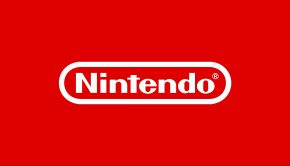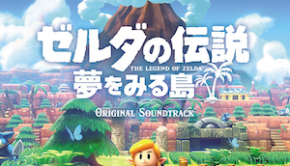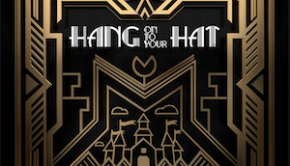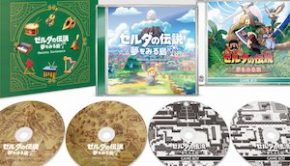The Legend of Zelda -Majora’s Mask- Original Soundtrack
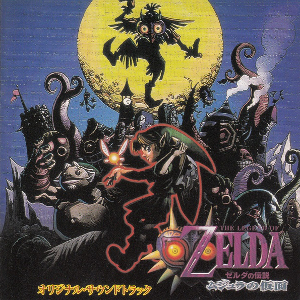 |
Album Title: The Legend of Zelda -Majora’s Mask- Original Soundtrack |
| Record Label: Pioneer (JP Edition); Nintendo of America (US Edition) |
|
| Catalog No.: PICA-2006; N/A |
|
| Release Date: June 23, 2000; November 15, 2000 |
|
| Purchase: Buy Used Copy |
Overview
Majora’s Mask is often considered the strangest and darkest Zelda game to date, but it was very familiar in other ways. The game brought a new world, a malevolent moon, plenty of masks, and a three day system, but offered little variation in most other departments. However, the game also had many characters, locations, and races that were parallel versions of what one encountered in Ocarina of Time. The gameplay also hadn’t changed much from Ocarina of Time — hello again, horses, fairies, real time battles, and young Link. Koji Kondo’s score was similarly familiar, featuring ocarina melodies, direct reprises from Ocarina of Time, and familiarly styled dungeon, action, and light-hearted music. However, it also presented a vivid interpretation of an unfamiliar but doomed world. The end result is a solid score that isn’t quite as polished as its predecessor…
Body
The soundtrack to Majora’s Mask provides a very good representation of the game’s peculiar storyline. In this title, the lonely bully Skull Kid uses the cursed artefact Majora’s Mask to summon the destruction of the mysterious world Termina; through repeatedly living three days through time travel, Link must prevent Termina’s moon from abandoning orbit and crashing into the world. The representation of the antagonist, the mask Majora, takes the form of a series of dramatic pieces influenced by Chinese opera. For example, the music for the title screen gradually darkens from a soft interpretation of the Clock Town music into the horrifying exposition of “Majora’s Theme”, as the threat above a bustling community is revealed.
The game revolves around Clock Town in the centre of Termina, a community where plenty of curious events happen over a three day period. The background music used there grows progressively more disturbing over the three days. After opening with the same morning music from the Ocarina of Time, “Clock Town – Day 1” develops into a lyrical piece of folk dance music with a very charming melody presented by a group of synthesized string and flute players. “Clock Town – Day 2”, on the other hand, is slightly eerie due to the removal of percussion and use of solo instruments, as opposed to ensembles, to represent the main melody; the minimalist approach makes it sound slightly ‘wrong’, even if the chord progressions and melody are well-preserved. “Clock Town – Day 3” is the darkest and most dissonant of all. It has a hurried tempo that reflects desperation and is accompanied by a descending chromatic string ostinato that gives a sense of impending doom. The final six hours of Clock Town’s existence are represented by “Last End,” one of the most emotional themes to ever appear on the Zelda franchise. Its deep chord progressions, synth swells, and carefully constructed ostinati assimilate into a piece that is simultaneously enchanting, saddening, and epic.
Like Hyrule, Termina is a colourful world and Kondo offers a diverse set of themes to represent this. Those who prefer Zelda’s more melodic pieces will be delighted to hear that, by popular demand, the overworld theme from The Legend of Zelda and A Link to the Past has returned. The unforgettable melody of “Termina Field” glides over the adventurous percussion-dominated accompaniment and is beautifully harmonised by orchestral instruments in places. Other highlights include the ethereal synth-dominated “Astral Observatory”, the folky gigue “Deku Nut’s Palace”, and the dark and imposing “Ikana’s Ancient Castle” and “Pirate Fortress”. The background music used to represent the four major areas of the game — “Marsh Land”, “Snow Mountain”, “Great Bay Beach”, and “Ikana Valley” — all extensively reference “Majora’s Theme”, representing their cursed nature. They’re well-arranged and very effective, though will be too abstract for some audiences.
Another theme that is reflective of the storyline is “Clock Tower”, used in the very first place Link ends up in Termina. Though it sounds similar to the observatory theme, it incorporates a melody known as the “Song of Healing” that is symbolic of healing Majora’s curse and, perhaps coincidentally, partly an inversion of “Saria’s Song” from Ocarina of Time. It is the first and arguably best theme that can be learnt on the ocarina in Majora’s Mask. Other ocarina themes include standard, speeded up, and inverted versions of “Song of Time” used for time travel, the emotional “Oath to Order” that can used to summon the four giants to save Termina at the end of the world, “Epona’s Song” and the “Song of Storms” carried over from Ocarina of Time, and four sadly forgettable ‘songs’ required to make each of the game’s dungeons appear.
There are numerous other reprises from Ocarina of Time presented on the score. These are mostly less important and rather simple themes like “Shop”, “House”, “Shooting Gallery”, “Mini Game”, various fanfares, and the themes used to represent the owl, the potion shop, and the windmill. Most of these reprises are charming and effective in the context of the game, though have a tendency to bore on the soundtrack, particularly when cluttered together. There are occasions when lack of arrangement is quite uninspiring. “Lon Lon Ranch” from Ocarina of Time, for example, is more or less replicated in “Romani Ranch”, except with a soothing violin replacing Epona’s voice. The wretched horse-racing themes from Ocarina of Time are featured in several unwelcome renditions. As for Ocarina of Time‘s “Goron City” itself, it is copied straight over to Majora’s Mask in “Goron’s Shrine”, along with “Zora’s Domain” (now “Zora Hall”) and “Lost Woods” (now “Woods of Mystery”). While there original incarnations were quite something, inspiring arrangements could have been made from them to reflect that the Gorons and Zoras live in new environments now; this would have helped to make their additions to the score less of a triviality and more of a highlight as well. Among the strangest reprises of all are used to represent instrument practice as part of a tedious sidequest that leads to the performance of the Zora band, The Indigo-Gos. “Drum Practice Music” is “Cave” from A Link to the Past while “Bass Practice Music” and “Piano Practice Music” are interpretations of the first Zelda game’s underworld and game over music.
Majora’s Mask‘s action themes are an improvement upon Ocarina of Time‘s generic rabble. This is principally due to the choice to replace Kondo with Toru Minegishi for the normal battle, middle boss, and end of dungeon boss themes. Minegishi knows how to combine a sense of action and intensity with interesting musical features and a certain amount of lyricism. Particularly effective is “Middle Boss Battle”, which is dominated by crisp brass phrases and a pulsing piano ostinato. Kondo contributes the unremarkable “Chase” at the start of the soundtrack as well as the four final boss themes. The final boss themes are all variants on “Majora’s Theme”, the first epic and symphonic, the second ominous and atmospheric, the third downright weird, and the final fast-paced and climactic; one is unlikely to regularly listen to these themes, given the abstract and somewhat unpleasant nature of the nonetheless ingenious motif they revolve around. Nevertheless, they are solid enough and highly effective in context.
As for the dungeon themes, like Ocarina of Time‘s, they’re ambient and experimental. “Woodfall Temple” features funky percussion use and exotic ululation, “Great Bay Temple” offers a collection of industrial percussion and repetitive electronic noises, and the much more melodic “Rockvale Temple” has ‘outside’ and ‘inside’ versions that are interestingly varied in a somewhat mathematical way. “Snowhead Temple” is cut short by a minute, receiving a similar fate to Ocarina of Time’s “Fire Temple” because of the album’s occasionally poor presentation; a little unfortunate given the piece most is the most stylistically interesting dungeon theme, featuring minimalist piano motifs, atmospheric noise, synth vocal drones, and plenty of electronic manipulation, though many will cope with the loss.
There’s a lot of original ‘filler’ in Majora’s Mask as well. Many of the light-hearted tracks are similar, irritating, and underdeveloped. Prime examples are “Major’s House Council Room”, “Milk Bar”, “Jungle Cruise”, and “Zora Band”, all of which are decent during gameplay, but not worth more than a few stand-alone listens. But there’s worse than that: “Jabu’s House” is one of the least inspiring ‘dark’ themes Kondo has ever written, “Cremia’s Wagon” is another unnecessary ranch-related theme, “Song of Frogs” is 21 seconds of frogs croaking, and “Music Box House” isn’t just an irritating rip-off of Super Mario 64‘s “Merry-Go-Round” but also of tonnes of other carousel themes as well. Talking about derivations, some of the references to other cultures are surprisingly bad given Kondo’s previous works. Particularly awful are the rather similar Middle Eastern-influenced themes “Kamaro’s Dance”, “Kishie’s Quiz”, and “Dancer”, which greatly disappoint after Super Mario 64‘s “Lethal Lava Land”. And then there’s cringe-worthy film parodies like the dated “Cucco House Game”, influenced by The Great Escape‘s score, and the UFO invasion tune “The Monsters Raid”. Fortunately, it ends well with a medley that incorporates a jubilant new melody and a full interpretation of The Indigo-Gos’ long-awaited jazz performance.
Summary
The soundtrack to Majora’s Mask is a somewhat disappointing successor to Ocarina of Time‘s. The amount of uninspired themes and reprises really lets down the album and there is a definite lack of inspiration. When the event themes, fanfares, reprises, and ocarina songs are added together, it becomes clear that Majora’s Mask’s 112 track score has considerably more filler than highlights; sometimes a dozen consecutive tracks feature only one or two ‘good’ themes, the rest being only effective in the context of the game, if at all. Nonetheless, the album is still quite entertaining to listen to in its entirety. This is due to a solid representation of the cursed nature of Termina, the inclusion of plenty of genuinely excellent action, dungeon, and location themes, and, of course, the bags of nostalgia that go with any Zelda score. It is a worthwhile purchase to anyone who enjoys Zelda music and played the game, but it will be a bit of a rocky ride.
Do you agree with the review and score? Let us know in the comments below!
3.5
Posted on October 31, 2015 by Chris Greening. Last modified on October 31, 2015.

